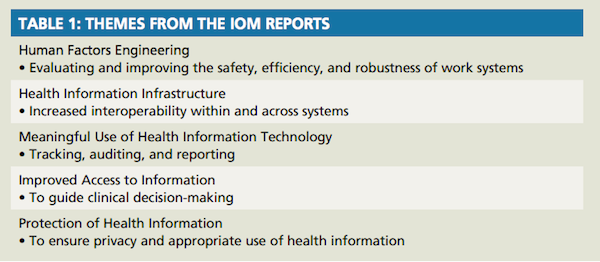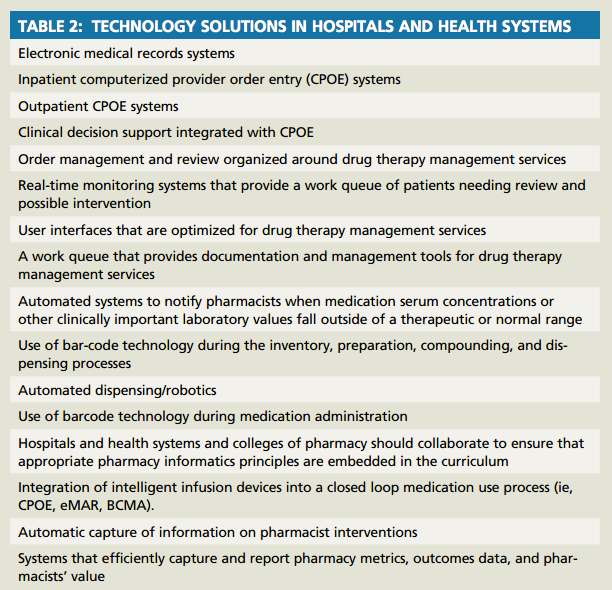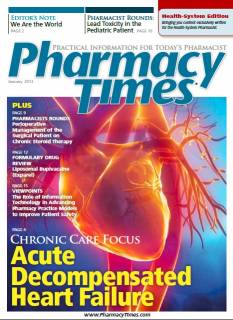Publication
Article
Pharmacy Practice in Focus: Health Systems
The Role of Information Technology in Advancing Pharmacy Practice Models to Improve Patient Safety
Author(s):
The role of information technology in pharmacy practice is dynamic and not likely to lose relevance in the coming years. To some degree, pharmacists are interested in information technology because we can envision it increasing efficiency in our daily tasks and improving our access to vital information. However, federal legislation is also driving adoption of Health Information Technology (HIT) for its potential impact on patient safety. This is not a new concept, as the role of HIT in reducing medical errors has been discussed on the national stage since
To Err is Human
.
1
What is new is our profession’s most recent initiative to evaluate our practice model. The American Society of Health-System Pharmacists’ (ASHP’s) Pharmacy Practice Model Initiative (PPMI) presents a unique opportunity to evaluate the delivery of pharmaceutical care in such a way that incorporates safe and effective adoption of HIT.2 It is pertinent at this time to consider evidence supporting PPMI recommendations related to HIT as well as barriers to successful implementation and utilization of HIT to support innovative pharmacy practice models.
According to the Office of the National Coordinator, HIT is defined as the application of information processing involving both computer hardware and software that deals with the storage, retrieval, sharing, and use of health care information, data, and knowledge for communication and decision making.3 The first of 2 reports from the Institute of Medicine (IOM), To Err is Human, suggests that if implemented appropriately, HIT should:
- Reduce reliance on memory
- Standardize terminology
- Use constraints, forcing functions, protocols, and checklists
- Minimize data handoffs
This report, among other things, encouraged careful consideration of information technology as a means of improving patient safety. Specifically, the IOM report promotes adoption of a proactive approach by examining processes of care for threats to safety and redesigning them before accidents occur, inclusive of HIT processes. Ancker et al describe the “Triangle Model” for evaluating the effect of HIT on quality and safety.4 This model acknowledges the interactions between technology, providers, and an organization to influence quality and safety outcomes, with patients at the center of the model.
Two years after To Err is Human, the second IOM report, Crossing the Quality Chasm, which was broader in scope than the first report, recommended that HIT be used to improve access to clinical information and support clinical decision-making. The report also recommended a national health information infrastructure. This infrastructure would not be some sort of centralized government database, as may be a common misconception. Rather, it could be described as “rules for the road.” Crossing the Quality Chasm defines the infrastructure as a set of technologies, standards, applications, systems, values, and laws that support all facets of individual health, health care, and public health. This standardization would support communication across the continuum of care and improve access to health information.
In keeping with the theme of standardization, the legislative response to these 2 reports, starting with the Medicare Prescription Drug Improvement and Modernization Act of 2003, aimed to increase interoperability and standardization by requiring Medicare Part D programs to support electronic prescribing.5 This prompted the creation of technical communication standards. Following in 2004, the Health Information Technology Adoption Initiative, an executive order, established the position of National Heath Information Technology Coordinator within the Department of Health and Human Services.6 This coordinator:
- Ensures that needed information is available at the time and place of care
- Improves health care quality, reduces medical errors, and advances the delivery of appropriate, evidence-based medical care
- Reduces health care costs resulting from inefficiency, medical errors, inappropriate care, and incomplete information
- Promotes more effective health care marketplace through widely available, accurate health information
- Improves the coordination across the continuum of care
- Ensures that patients’ individually identifiable health information is secure and protected
It was not until the Health Information Technology for Economic and Clinical Health (HITECH) Act of 2009 that legislative efforts gained “teeth” in the form of requirements for incentive payments and reimbursement.7 This act empowered the national coordinator, established standards and certifications, encouraged protection and privacy for health information, and established Meaningful Use criteria.
Stage 1 of meaningful use involves optional participation with incentive payments beginning in 2011. Institutions adhere to 20 “core” requirements, and choose 5 out of 10 “menu” items. In 2015, Medicaid and Medicare reimbursement adjustments are made in lieu of incentive payments. Stages 2 and 3 begin in 2013 and 2015, respectively, and each builds upon the previous stage in terms of requirements. Not all measures for each stage have been decided at this point, but each is meant to ensure that health care providers are making meaningful use of health information technology.

Overriding themes from the IOM reports and legislative response include human factors engineering, health information infrastructure, meaningful use of HIT, improved access to health information for decision making, and protection of health information (Table 1).
Unfortunately, the rate of implementation of HIT, specifically those aspects that affect the practice of pharmacy, is still less than ideal. As of 2007, some HIT has been widely adopted. Greater than 80% of institutions surveyed had adopted automated dispensing cabinets and repackaging automation.8 However, implementation of pharmacy information systems that interface with other HIT was only 51% and use of bar-code medication administration or electronic medication administration record was only 46%. Perhaps most alarming, as of 2010, only 14% of institutions surveyed utilized inpatient computerized provider order entry with decision support. Since 2007 and 2010, implementation has improved as described in the ASHP 2011 survey, but this information was not available prior to the PPMI summit.8
In 2011, Siska and Tribble described challenges related to HIT and performed a gap analysis based on the ideal future state of pharmacy HIT adoption.9 Barriers identified include cost, adverse effects, resistance to change, insufficient staffing, interoperability issues, and privacy concerns. Although some of these are only perceived barriers, most are real and significant. However, many can be overcome or mitigated through proper evaluation and careful implementation, which are supported by the evidence reviewed thus far in this article. The gap analysis describes a future state laden with terms such as continuum of care, standardization, interoperability, track, audit, and evaluation. These concepts are supported by the IOM reports and legislative response, but how do PPMI recommendations match up?
PPMI recommendations are displayed in Table 2, and have been displayed in 2 different groups for the purposes of discussion. The first are recommendations related to specific HIT. Although the use of these technologies is supported by the reports and legislation reviewed here, the overriding themes and the future state described in the HIT gap analysis focus less on specific technologies and more on the general approach to HIT implementation and utilization.

Each of these technology solutions is part of a larger recommendation simply stating that they enable the advancement of practice models. All other recommendations are very much in line with the concepts discussed here. Not only do PPMI recommendations address human factors engineering, HIT design, and patient safety, but they also add to the discussion by addressing the concept of training pharmacy students, residents, and practicing pharmacists on the proper use of HIT.
In conclusion, it would seem that technology-related PPMI recommendations are in line with patient safety efforts as evidenced by the IOM reports and federal regulation. As pharmacists, we are fortunate to be evaluating our practice model at a time when legislation is requiring health care providers to make meaningful use of HIT to care for patients in a safe and financially responsible way. It is encouraging that we have reached consensus in such an important time in a way that is supported by other best practice statements as well as legislative initiatives.
Jacob Holler, PharmD, MS, BCPS, is a pharmacy specialist at the pharmacistdirected anticoagulation service at the Henry Ford Hospital Department of Pharmacy Services in Detroit, Michigan.
References
- Institute of Medicine: To Err Is Human: Building a Safer Health Care System. Washington, DC: National Academy Press, 2000.
- American Society of Health-System Pharmacists. The consensus of the Pharmacy Practice Model Summit. Am J Health-Syst Pharm. 2011; 68:1148-1152.
- Health IT terms glossary. HealthIT.gov website. http://healthit.hhs.gov/portal/server.pt/community/health_it_hhs_gov__glossary/1256. Accessed December 7, 2012.
- Ancker JS, Kern LM, Abramson E, Kaushal R. The Triangle Model for evaluating the effect of health information technology on healthcare quality and safety. J Am Med Inform Assoc. 2012;19:61e65.
- Medicare prescription drug improvement and modernization act. US Government Printing Office website. www.gpo.gov/fdsys/pkg/PLAW-108publ173/pdf/PLAW-108publ173.pdf. Accessed December 7, 2012.
- Executive order 13335: Incentives for the use of health information technology and establishing the position of the National Health Information Coordinator. US Government Printing Office website. www.gpo.gov/fdsys/pkg/FR-2004-04-30/pdf/04-10024.pdf. Accessed December 8, 2012.
- Health information technology for economic and clinical health act. Department of Health and Human Services website. www.hhs.gov/ocr/privacy/hipaa/understanding/coveredentities/hitechact.pdf. Accessed December 8, 2012.
- Pedersen CA, Schneider PJ, Scheckelhoff DJ. ASHP national survey of pharmacy practice in hospital settings: dispensing and administration. Am J Health-Syst Pharm. 2011;69:768-785.
- Siska MH and Tribble DA. Opportunities and challenges related to technology in supporting optimal pharmacy practice models in hospitals and health systems. Am J Health-Syst Pharm. 2011;68:1116-1126.







